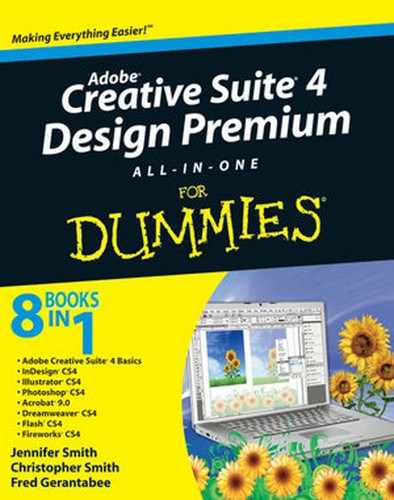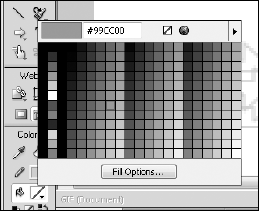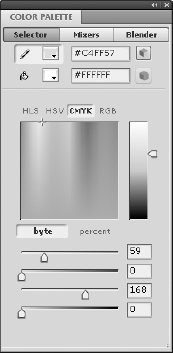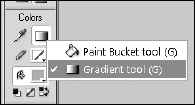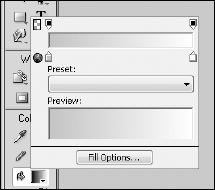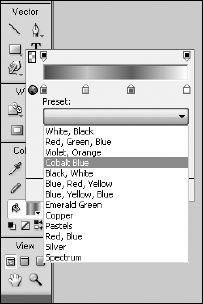Like most other Creative Suite applications, Fireworks lets you define an object's fill and stroke. You can use some unique tools for that selection, as well as some hidden features that work slightly differently from what you may be used to.
In this chapter, you find out how to get the fill or stroke color you want applied to your artwork, and you discover the basics of working with gradient fills.
Colors appear different on a monitor from the way they do when you view them off-screen, but this issue isn't as serious now as it was in the past. Years ago, you had to base your color selections on the lowest common denominator. Today, most viewers have monitors that can display thousands, if not millions, of colors.
Note
When you're choosing a color for the Web, it's best not to fret over the exactness of a color when viewed on different monitors unless precision is critical. Critical color could apply to your company logo or to fabrics that viewers might be comparing onscreen.
In Fireworks, you can choose color from several panels, with each panel offering a different model from which to create your colors. Even though you are working in RGB (Red, Green, Blue), you can still enter CMYK (Cyan, Magenta, Yellow, Key or Black) or HSB (Hue, Saturation, Brightness) values.
Perhaps you want to create a simple shape with a fill, which seems easy, but if you are unfamiliar with Fireworks, you may need a little direction to get this task done.
You can find most of Fireworks's color functions in the Colors section of the Tools panel. This section features an Eyedropper tool for sampling color, as well as color boxes that make it easy for you to stroke and fill both bitmap and vector graphics.
You can set additional attributes for color in the Properties panel, including textures that you can apply from the Texture drop-down list.
To create and color an object, follow these steps:
Choose File
New to create a new blank document.
Create a path or a shape with the bitmap or vector drawing tools and leave that object selected.
To apply a fill color, click the Fill Color box located at the Colors section of the Tools panel and then click the color you want to apply from the pop-up Swatches panel (see Figure 3-1).
To apply a stroke color, click the Stroke Color box in the Tools panel and then click the color you want to apply from the pop-up Swatches panel.
Assigning a fill or stroke color to graphics is relatively simple. But what if the color you want to use isn't in the default Swatches panel? In that case, you need to create a color and add it to the panel. You can accomplish this task in several ways. In the following sections, we cover using the Eyedropper tool and the color palette.
The Eyedropper tool is useful when you have a color to sample. Just select the tool, click any color (in your working document or in any other open Fireworks document), and then choose Window
Tip
To remove a color from the Swatches panel, position your mouse pointer over the color that you want to delete, and press Ctrl+Alt (Windows) or
The color palette is a dynamic and fun way to set color. It consists of three tabs, each tab offering the opportunity to choose a stroke or fill color and a different method of selecting that color.
You can open the Color palette by choosing Windows
The three color palette tabs are
Selector: The Selector tab (see Figure 3-2) lets you pick a color in any of four color models: HLS (hue, lightness, saturation), HSV, CMYK, and RGB. Click the large color panel and then enter color values by using the sliders or text boxes at the bottom. To adjust the tonal value, use the slider to the right of the large color panel.
Mixers: The Mixers tab (see Figure 3-3) lets you assign multiple colors by using the color wheel. You can also create a tint build at the bottom of the window so that you can build combinations of colors. In addition, you can export the colors as a bitmap or a table using the Export buttons on the left side of the Mixer tab, which makes it easy to reference them later.
Blender: The Blender tab (see Figure 3-4) lets you select two colors and then view and choose combinations of those colors.
You can add some dimension to a graphic by filling it with a gradient. To create a gradient in Fireworks, follow these steps:
Create a shape that you want to fill with a gradient.
With the shape selected, click and hold the Paint Bucket tool in the Colors section of the Tools panel and then select the hidden Gradient tool (see Figure 3-5).
Click the Fill Color box in the Tools panel to assign colors to the gradient.
The Fill Options window appears (see Figure 3-6).
To assign colors to the gradient, simply click the existing color stops, and choose a color from the pop-up palette.
Click anywhere on the gradient ramp to add a stop, and edit the color.
If you don't want to create your own gradient, click the Preset drop-down list to choose among existing gradients (see Figure 3-7).
